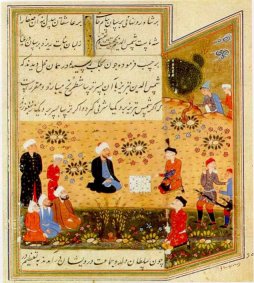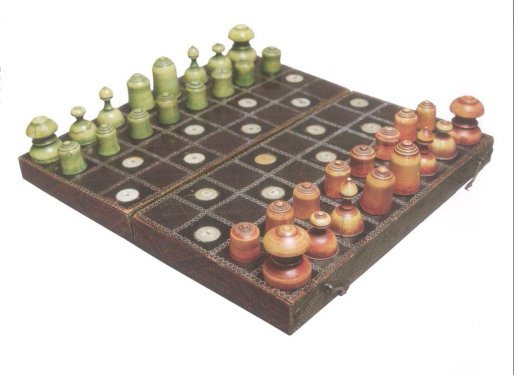Shatranj, medieval Arabic Chess
Within 638-651, Muslim troops defeated and conquered the Persian empire. There, they soon assimilated the culture of their enemies. The Persian elite adopted Islam and, in return, they were very important contributors to the bright civilization that shone from Middle East. Chess is a good example of that success. The Arabs learned Chatrang that became Shatranj after a phonetic evolution from Persian to Arabic. They brought Shatranj to the level of science, publishing several treatises of problems (mansubat) and openings (ta'biyat).
Al-Adli (800-870), ar-Razi (dead <900), as-Suli (854-946), al-Lajlaj (900-970), where among the best players of their time, living and becoming famous at Caliphs court in Baghdad. Al-Ya‘qubi (dead in 907), at-Tabari (838-923), al-Masudi (circa 940-950), Daqiqi (dead in 975), Firdawsi (circa 1010), ath-Tha'alibi (961-1038), al-Bêruni (973-1048), Mahmud al-Amuli (dead in 1352) are also famous Muslim authors and intellectuals who wrote about the game.
Illustration of Shatranj piece in Thomas Hyde's book (Mandragorias, seu, Historia shahiludii, 1694)
RULES:
The board was uniform with 8x8 squares. Each
players has 16 pieces, usually green (or black) and red: 1 Shah
(King)![]() ,
1 Firzan (Minister)
,
1 Firzan (Minister)![]() ,
2 Fil (Elephant)
,
2 Fil (Elephant)![]() ,
2 Faras (Horse)
,
2 Faras (Horse)![]() ,
2 Rukh (no meaning)
,
2 Rukh (no meaning)![]() and 8 Baidaq (Soldiers)
and 8 Baidaq (Soldiers)![]() .
.
The Shah of both sides are always facing. Shah and Firzan could be inverted, but always both sides together. However, it most Muslim manuscripts, south Shah was in d1. Murray says that it was common that North starts the game.

The moves of the Shah, Faras and Rukh are exactly the same than the modern King, Knight and Rook. However, there is no castling.
The Baidaq also moves and captures like the modern Pawn. The differences are that the initial double step and the prise-en-passant are unknown here. The Pawn promotes to a Firzan when reaching the last row, whatever the number of Firzans on the board.
The moves of the Firzan and the Fil are much more limited that our modern Queen and Bishop. They could move diagonally only, 1 step for the Firzan and 2 steps - jumping - for the Fil.

Moves
of Firzan (Minister) and Fil (Elephant)
The were 3 ways of winning:
Checkmate the Shah. Shah mat meant "the King is dead" in Persian, and this has been transmitted with phonetical evolution to give the word "checkmate".
Stalemate when the only possible move was putting the Shah in capture. (This is a draw in modern Chess).
Bare the opposite Shah, leaving him isolated with all his army captured.


More illustrations from Arab manuscripts. Click to enlarge.
HISTORY:
The sound "ch" does not exist in arabic. When the Arabs sized the Persian Sassanian empire, in the 7th century, they altered the name Chatrang which became Shatranj.
On the first centuries, the progress of the game was discrete. The first mention is just an evokation of Pawn promotion inside a poem from al-Farazdaq (†728). But, everything changed with the Abbasid dynasty. Around the middle of the 9th century, the game came in favor in Baghdad. All great Muslim historians al-Ya‘qubi, at-Tabari, al-Ma‘sudi, wrote about Shatranj. In 988, Ibn an-Nadim compiled a list of authors of Shatranj books. There the first great masters can be found, al-‘Adli, ar-Razi, as-Suli and al-Lajlaj, all authors of works whose originals have been lost but which were copied in about 15 manuscript composed between the 12th and the 17th centuries. Their study has allowed Harrold James Ruthen Murray, a great historian, to re-build the heritage of those great masters from the Califate of Baghdad.
Muslim conquests brought Shatranj at the frontiers of Islam. It even went further, in Christian Europe in the West, in Russia in the North, in Africa in the South and it went back to India in the East. But, after several centuries of stability, it finally vanished in front of the modern rules coming from Europe, except with the Muslims in British India ("Rumi" Chess), in Ethiopia (Senterej) and at Madagascar (Samantsy) where it survived with some minor changes until the beginning of 20th. century.
VARIANTS:
Since its early days, Shatranj got several variants. Several should have known some success as they are evoked in different sources. They were described in the above mentioned manuscripts. In addition, two writers paid a special attention to those variants:
The historian al-Mas'udi (dead in 956) composed the Muruj adh-dhahab (The Meadows of gold). Among other things, this text described five variants: Oblong Chess (al-Mustatila), Decimal Chess (at-Tamma, complete Chess), Circular Chess (ar-Rumiya, Byzantine Chess), Astronomical Chess (al-Falakiya, Celestial Chess) and Limb Chess (al-Jawarhiya).
Much later, the Nafa'is al-funun (Treasury of the sciences), a Persian encyclopedia from Mahmud al-amuli (died 1352) described five historical chess variants: 1) Shatranj at-Tawila, oblong chess, 2) Shatranj al-Mudawara, Circular Chess, 3) an astronomical game as in Alfonso's, 4) Shatranj al-Husun, "Citadel" Chess, 5) Shatranj al-Kabir, Great Chess later known as Timur Chess.
















